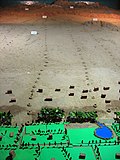Turpan
Turpan, also referred to Turfan or Tulufan in Chinese, is an oasis county-level city in Xinjiang Uyghur Autonomous Region of China.
Background
Historically, Turpan is an important ancient stop on the Silk Road in China.[1] Turpan means 'the lowest place' in Uygur and 'the fertile land' in Turki. Now the city is a tourist spot with unique landscape, abundant historical relics and fertile farmland.
Turpan Media
Wall painting from a Christian church, Qocho (Gaochang) 683–770 CE
Maheshvara, Turpan, 10th–12th century
Buddhist Uyghur king from Turpan attended by servants. Depicted in Dunhuang Mogao Caves, Western Xia dynasty.
Pranidhi scene, Turpan, 10th–12th century.
"Mughal embassy", seen by the Dutch visitors in Beijing in 1656. According to Lach & Kley (1993), modern historians (namely, Luciano Petech) think that the emissaries portrayed had come from Turpan, rather than all the way from the Moghul India.
A model of the Turpan water system, (karez) in the Turpan Water Museum: Water is collected from mountains and channeled underground to grape vineyards.
Flaming mountains are near Turfan. Close to Bezeklik caves. *Are mountains with a "supposed" appearance of fire flames due to his shape and colours. There is also an ancien chinese roman, "The journey to the West" based in life of buddhist monk Xuan Zang (XVI century), that tells an story about a monkey that helps monk to pass the "Inferno flami









